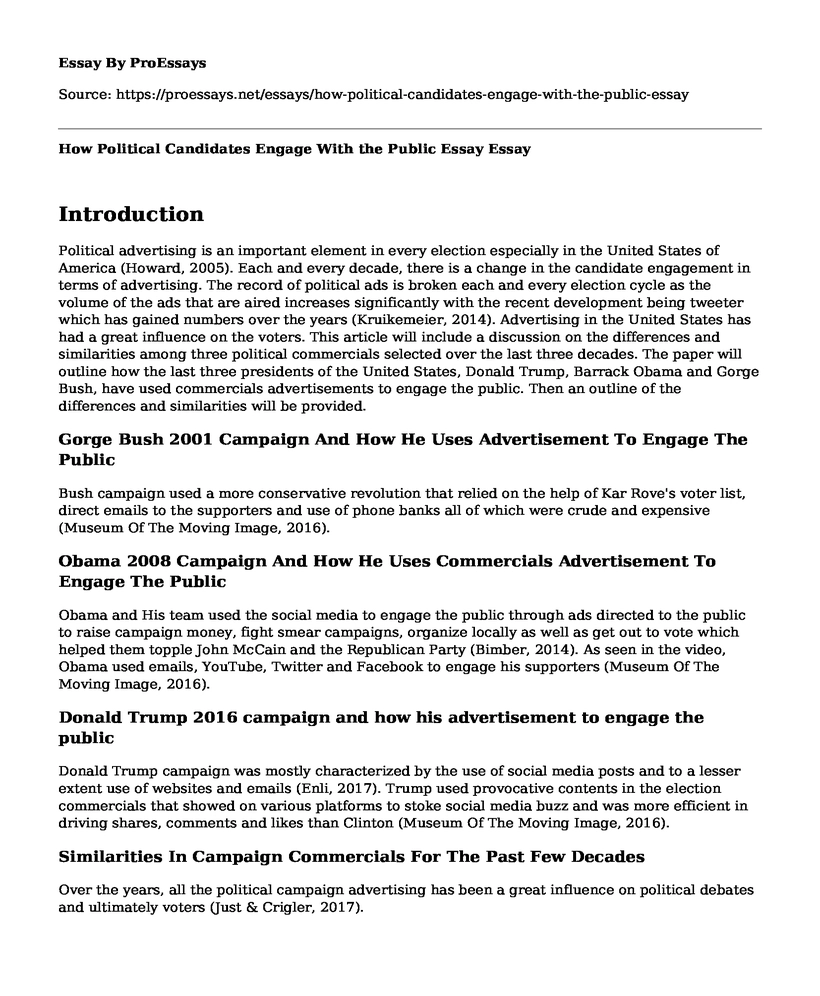Introduction
Political advertising is an important element in every election especially in the United States of America (Howard, 2005). Each and every decade, there is a change in the candidate engagement in terms of advertising. The record of political ads is broken each and every election cycle as the volume of the ads that are aired increases significantly with the recent development being tweeter which has gained numbers over the years (Kruikemeier, 2014). Advertising in the United States has had a great influence on the voters. This article will include a discussion on the differences and similarities among three political commercials selected over the last three decades. The paper will outline how the last three presidents of the United States, Donald Trump, Barrack Obama and Gorge Bush, have used commercials advertisements to engage the public. Then an outline of the differences and similarities will be provided.
Gorge Bush 2001 Campaign And How He Uses Advertisement To Engage The Public
Bush campaign used a more conservative revolution that relied on the help of Kar Rove's voter list, direct emails to the supporters and use of phone banks all of which were crude and expensive (Museum Of The Moving Image, 2016).
Obama 2008 Campaign And How He Uses Commercials Advertisement To Engage The Public
Obama and His team used the social media to engage the public through ads directed to the public to raise campaign money, fight smear campaigns, organize locally as well as get out to vote which helped them topple John McCain and the Republican Party (Bimber, 2014). As seen in the video, Obama used emails, YouTube, Twitter and Facebook to engage his supporters (Museum Of The Moving Image, 2016).
Donald Trump 2016 campaign and how his advertisement to engage the public
Donald Trump campaign was mostly characterized by the use of social media posts and to a lesser extent use of websites and emails (Enli, 2017). Trump used provocative contents in the election commercials that showed on various platforms to stoke social media buzz and was more efficient in driving shares, comments and likes than Clinton (Museum Of The Moving Image, 2016).
Similarities In Campaign Commercials For The Past Few Decades
Over the years, all the political campaign advertising has been a great influence on political debates and ultimately voters (Just & Crigler, 2017).
All the three presidential candidates conducted their campaign in a time where the environment was favourable a the market was free for broadcasting political messaging from which all benefited as they were able to engage their voters.
All the three presidential candidates were able to properly utilize advertising through various platforms. The candidates were able to benefit greatly as they were able to pass their intended message to larger groups of people with minimal physical effort as well as reduced costs (Just & Crigler, 2017).
Differences In Of Campaign Commercials For The Past Few Decades
While President Obama and President Bush used paid commercials, President Donald Trump did not use any paid commercials. He mostly engaged in tweets, Facebook posts among others. Due to his controversy, Donald Trump enjoyed free media coverage from the cable news channels. Therefore, he did not need to purchase commercials. It should be noted that Trump did not run any television advertisement at all (Enli, 2017).
Although the last president, Obama and Trump mostly depended on the social media through the various platform, the campaign carried by Bush was not mainly on the social media but on physical campaigns.
There is a notable difference in the kind of advertising carried out by Bush and the one carried out by the other two presidents. President Bush used voter list, direct emails to his supporters and use of phone banks all of which were crude and expensive. However, Obama and Trump used more modern platforms such as Twitter, Facebook, YouTube among others (Enli, 2017).
References
Bimber, B. (2014). Digital media in the Obama campaigns of 2008 and 2012: Adaptation to the personalized political communication environment. Journal of Information Technology & Politics, 11(2), 130-150.
Enli, G. (2017). Twitter as arena for the authentic outsider: exploring the social media campaigns of Trump and Clinton in the 2016 US presidential election. European Journal of Communication, 32(1), 50-61.
Howard, P. N. (2005). Deep democracy, thin citizenship: The impact of digital media in political campaign strategy. The ANNALS of the American Academy of Political and Social Science, 597(1), 153-170.
Just, M. R., & Crigler, A. (2017). Political Advertising in the United States. Routledge Handbook of Political Advertising, 279.
Kruikemeier, S. (2014). How political candidates use Twitter and the impact on votes. Computers in Human Behavior, 34, 131-139.
Museum Of The Moving Image, (2016). The Living Room Candidate. Presidential Campaign Commercials 1952 - 2016
Cite this page
How Political Candidates Engage With the Public Essay. (2022, Jul 08). Retrieved from https://proessays.net/essays/how-political-candidates-engage-with-the-public-essay
If you are the original author of this essay and no longer wish to have it published on the ProEssays website, please click below to request its removal:
- How Political Candidates Engage With the Public Essay
- Computers, Technology, and Criminalistics in Policing Essay
- Policy Recommendation Essay Sample
- Essay Example on 1960s Health Care Reform: The Birth of Medicare & Medicaid
- Essay Example on Klu Klun Klan: Indy Newspaper's Crusade for Democracy
- Donald Trump Tries to Erase Tweets Blasting Journalists on Coronavirus Response - Essay Sample
- Spanish Parliamentary Monarchy: A Brief Overview - Essay Sample







